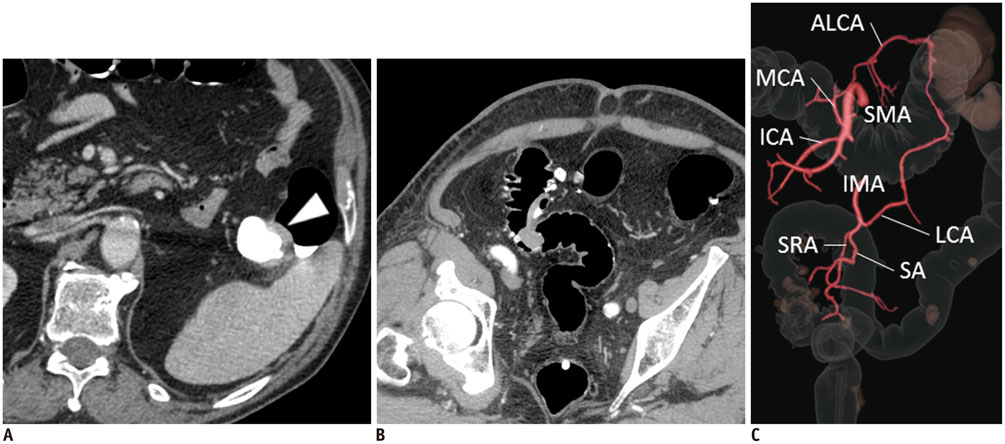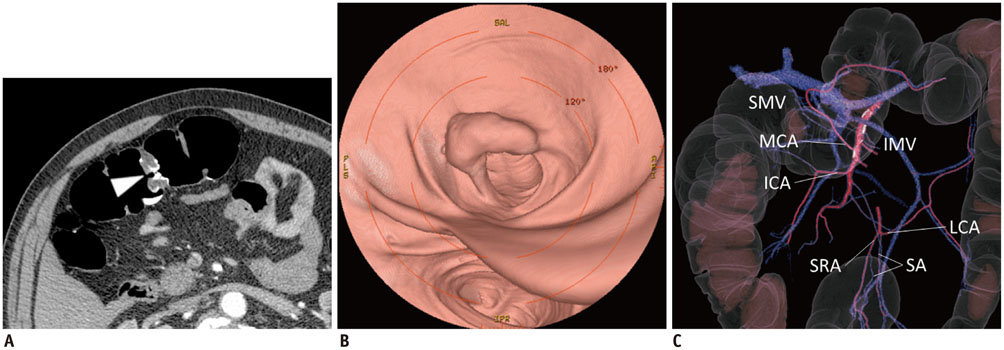Korean J Radiol.
2015 Aug;16(4):821-826. 10.3348/kjr.2015.16.4.821.
Vascular Map Combined with CT Colonography for Evaluating Candidates for Laparoscopic Colorectal Surgery
- Affiliations
-
- 1Unita Operativa di Radiologia Diagnostica e Interventistica, Azienda Ospedaliera San Paolo, Milan 20142, Italy. nicola.flor@ao-sanpaolo.it
- 2Dipartimento di Scienze della Salute, Universita degli Studi di Milano, Milan 20142, Italy.
- 3Scuola di Specializzazione in Radiodiagnostica, Facolta di Medicina e Chirurgia, Universiti degli Studi di Milano, Milan 20122, Italy.
- 4Unita Operativa di Chirurgia, Azienda Ospedaliera San Paolo, Milan 20142, Italy.
- KMID: 2155555
- DOI: http://doi.org/10.3348/kjr.2015.16.4.821
Abstract
- Contrast-enhanced computed tomography colonography (CE-CTC) is a useful guide for the laparoscopic surgeon to avoid incorrectly removing the colonic segment and the failure to diagnose of synchronous colonic and extra-colonic lesions. Lymph node dissection and vessel ligation under a laparoscopic approach can be time-consuming and can damage vessels and organs. Moreover, mesenteric vessels have extreme variations in terms of their courses and numbers. We describe the benefit of using an abdominal vascular map created by CE-CTC in laparoscopic colorectal surgery candidates. We describe patients with different diseases (colorectal cancer, diverticular disease, and inflammatory bowel disease) who underwent CE-CTC just prior to laparoscopic surgery.
MeSH Terms
Figure
Reference
-
1. Neri E, Turini F, Cerri F, Faggioni L, Vagli P, Naldini G, et al. Comparison of CT colonography vs. conventional colonoscopy in mapping the segmental location of colon cancer before surgery. Abdom Imaging. 2010; 35:589–595.2. Flor N, Ceretti AP, Mezzanzanica M, Rigamonti P, Peri M, Tresoldi S, et al. Impact of contrast-enhanced computed tomography colonography on laparoscopic surgical planning of colorectal cancer. Abdom Imaging. 2013; 38:1024–1032.3. Park SH, Lee JH, Lee SS, Kim JC, Yu CS, Kim HC, et al. CT colonography for detection and characterisation of synchronous proximal colonic lesions in patients with stenosing colorectal cancer. Gut. 2012; 61:1716–1722.4. Flor N, Rigamonti P, Pisani Ceretti A, Romagnoli S, Balestra F, Sardanelli F, et al. Diverticular disease severity score based on CT colonography. Eur Radiol. 2013; 23:2723–2729.5. Regge D, Neri E, Turini F, Chiara G. Role of CT colonography in inflammatory bowel disease. Eur J Radiol. 2009; 69:404–408.6. Fleshman J, Sargent DJ, Green E, Anvari M, Stryker SJ, Beart RW Jr, et al. Laparoscopic colectomy for cancer is not inferior to open surgery based on 5-year data from the COST Study Group trial. Ann Surg. 2007; 246:655–662. discussion 662-6647. Veldkamp R, Kuhry E, Hop WC, Jeekel J, Kazemier G, Bonjer HJ, et al. Laparoscopic surgery versus open surgery for colon cancer: short-term outcomes of a randomised trial. Lancet Oncol. 2005; 6:477–484.8. Ignjatovic D, Sund S, Stimec B, Bergamaschi R. Vascular relationships in right colectomy for cancer: clinical implications. Tech Coloproctol. 2007; 11:247–250.9. Spasojevic M, Stimec BV, Fasel JF, Terraz S, Ignjatovic D. 3D relations between right colon arteries and the superior mesenteric vein: a preliminary study with multidetector computed tomography. Surg Endosc. 2011; 25:1883–1886.10. Hirai K, Yoshinari D, Ogawa H, Nakazawa S, Takase Y, Tanaka K, et al. Three-dimensional computed tomography for analyzing the vascular anatomy in laparoscopic surgery for right-sided colon cancer. Surg Laparosc Endosc Percutan Tech. 2013; 23:536–539.11. Mari FS, Nigri G, Pancaldi A, De Cecco CN, Gasparrini M, Dall'Oglio A, et al. Role of CT angiography with three-dimensional reconstruction of mesenteric vessels in laparoscopic colorectal resections: a randomized controlled trial. Surg Endosc. 2013; 27:2058–2067.12. Matsuki M, Okuda J, Kanazawa S, Kanamoto T, Inada Y, Tatsugami F, et al. Virtual CT colectomy by three-dimensional imaging using multidetector-row CT for laparoscopic colorectal surgery. Abdom Imaging. 2005; 30:698–708.13. Belizon A, Sardinha CT, Sher ME. Converted laparoscopic colectomy: what are the consequences? Surg Endosc. 2006; 20:947–951.14. Kobayashi M, Morishita S, Okabayashi T, Miyatake K, Okamoto K, Namikawa T, et al. Preoperative assessment of vascular anatomy of inferior mesenteric artery by volume-rendered 3D-CT for laparoscopic lymph node dissection with left colic artery preservation in lower sigmoid and rectal cancer. World J Gastroenterol. 2006; 12:553–555.15. Horton KM, Fishman EK. Volume-rendered 3D CT of the mesenteric vasculature: normal anatomy, anatomic variants, and pathologic conditions. Radiographics. 2002; 22:161–172.
- Full Text Links
- Actions
-
Cited
- CITED
-
- Close
- Share
- Similar articles
-
- Efficacy of CT Colonography in the Detection of Colorectal Polypoid Lesions
- Diagnostic Performance of CT Colonography for the Detection of Colorectal Polyps
- A Comparison of Patient Acceptance and Preferences Between CT Colonography and Conventional Colonoscopy in Colorectal Cancer Screening
- Virtual CT Colonoscopy and Virtual CT Barium Enema using Multidetector-row CT
- Utility of CT colonography in detecting colon polyps as a colon cancer screen










